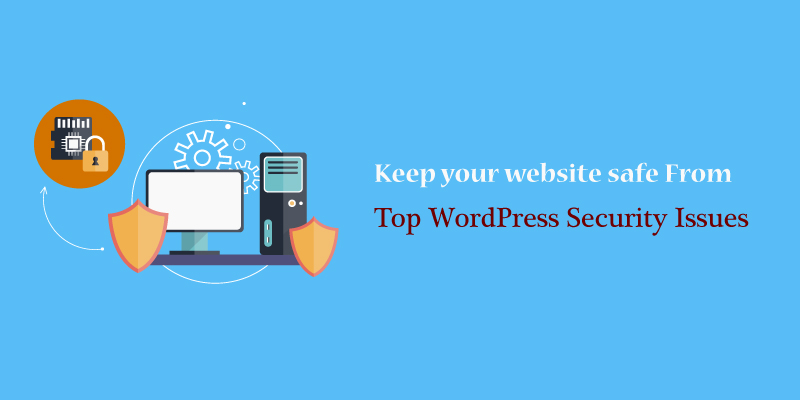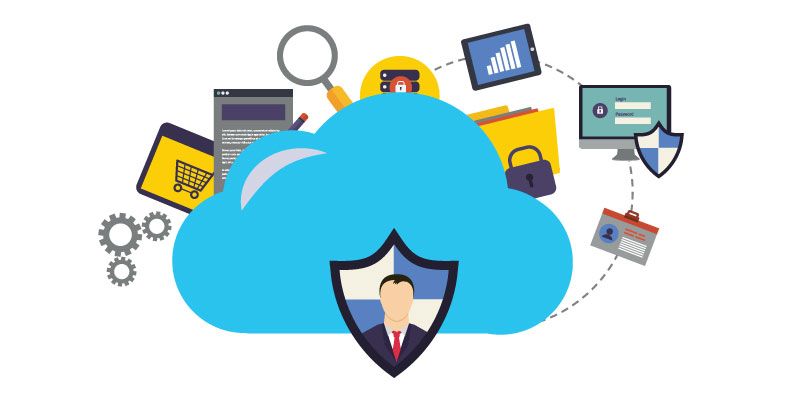
How to Secure Yourself from WordPress Security Threats
This article aims to assist you in understanding all WordPress security fundamentals & eliminate WordPress security threats of your website. Presently, the most popular publishing platform all over the world is WordPress. Indeed, it runs more than 34% of all websites in the entire world. Further, this platform is open-source. This means everyone can see the code which runs WordPress.
Hackers pose serious WordPress security threats in your WordPress website. Assume you are a hacker and you intend to infect numerous websites as you can. You will either look for a security hole in a specific software which operates on every website? Or, you will find a security hole in popular software that is used by websites for instant infection on all sites?
So, if a hacker gets a security hole in either a WP theme or plugin or WordPress itself, then this lets them use automated attacks to infect numerous websites.
Because of this, hackers look for a “zero-day” security hole in WordPress, as it might give them the capacity to have control of thousands of websites. Any vulnerability which the software developer has spent “zero days” in fixing is known as Zero-Day Vulnerability.

This kind of security hole is best for any hacker, as anyone who runs the new version of specific software is assured of having that hole without a solution.
What are the reasons for the WordPress Security Threats?
Here are the three forces which attack WordPress websites:
- Botnet: A group of machines which runs programs which get coordinated from a central server. These programs attack multiple sites using automated methods & is one of the major WordPress security threats.
- Humans: A person who sits at a keyboard manually, investigating and attacking a target website.
- A single bot: A single script or automated program which a hacker utilizes to attack multiple websites in an automated method.
Bots and Botnets
Bots are simply programs which hackers have written, and whose main target is multiple websites. And, they work by searching for vulnerabilities in popular software such as WordPress. Writing a program which visits thousands of sites within a short time to examine if they are using a WordPress version with a security hole is easier. The aim is to use this security hole to hack these sites.
Also, bots might be a single program working on a single machine. Or, many machines running many versions of the program, with multiple hacking websites in parallel. These are known as botnets.
Robots perform the majority attacks on WordPress sites. But, these attacks are not complex like human attacks. Besides that, these attacks are aggressive, making it easier to detect them. On the contrary, these types of automated attacks may compromise hundreds of websites if a zero-day vulnerability is exploited on a popular theme, plugin or WordPress.
Note: Automated machines or Bots perform the most attacks, as they are swift and successful at attacking many websites. Thus, you should close all security holes on your WP site as soon as possible.
Human Attackers

Nonetheless, if a person targets you, the complexity of the attack is higher than that of a robot. Remember, a human attacker is capable of controlling the speed of gathering information on your website to avoid any detection. After that, they can test some attacks with caution, to avoid alerting you and the systems securing the site. They make decisions on whether to proceed with an attack or not based on the outcomes of every attempt.
The targets of most human attacks are useful websites, such as those that are financially lucrative, with sensitive private data, and defense contractors.
Why do attackers attack your WordPress Website?
The objective of any attacker is reaching the administrative level to control your WordPress website. As a result, they are capable of reading all data and files available in your website database. Besides that, they can change how your site behaves, the content it serves, change the database, and modify files.
The reasons what attackers want to be capable of doing:
- Attack other websites: After an attacker compromises your website, he/she can use it in running bot attack scripts which hack in other sites. In turn, your website becomes part of their botnets.
- Spamvertize: They are using your website to redirect traffic to other dangerous or spam sites. Also, adding their sites in spam emails take the emails in spam folders in any case the website is known as dangerous. So, adding your website address in their spam emails ensures spam filters do not block them. Thus, any person who gets spam clicks on the link to your website, and get redirected to the harmful website.
- Stealing your website data: One of the hacking reasons is accessing and harvesting data on your website, which includes names and email addresses of your customers and members. In turn, the members become targets of the hackers, as they send them dangerous and spam emails. Besides that, your website might contain special data such as private member information which is essential in identity theft. And, in conducting other dangerous activities.
- Send spam:to have the ability to send spam emails using your website. Once hackers get control of your website, they run scripts on your site for a bulk email to their targets.
- To avoid filters and host dangerous content: Once they gain control of your site, hackers might use it to host content such as illegal drug sales, pornography, and other spams. Since your domain has a good reputation, hackers can avoid spam and online filters.
How do attackers attack your WordPress Website?
Basically, there are two stages of any website attack. First, the reconnaissance stage where either a human or bot attacker is collecting your website information. Second, the exploitation stage where attackers try to access your website using the information collected.
Reconnaissance
At this phase, the attacker gathers crucial information regarding your website. This information helps them know any vulnerabilities available for exploitation. Besides that, the two most essential things that they want to know are: what type of software your website runs? And, the versions of this software.
Reason being, the internet has many databases which list the versions of software and all vulnerabilities linked with each. For instance, if a hacker knows you are running WordPress version 4.2.2, then they understand your site has a serious cross-site script vulnerability for exploitation.
However, if the hackers realize your site runs a newer version, they will not think to try and exploit that vulnerability. They always avoid getting detected by not exploiting vulnerabilities which are not on your server.
Before trying any hacking attempt, hackers try gathering information about your site as much as possible. But, knowing the software, you are running, and the type of version for every software on your site is of great value.
Therefore, “enumerating” your themes and plugins is among the things that hackers when they attack your website. This provides them with a list of all your WP themes and plugins, as well as their versions. After that, they will cross-reference their exploit list with your list to know if they can try exploiting any of your themes or plugins.
Further, it is essential to know if there are other WordPress installations on your website before hacking. Did you make the backup of your site a copy of the whole WordPress directory to a sub-directory? If so, it is accessible on the web.
Moreover, you do not keep the files in the backup directory by doing so. These files can be executed from the web, and like any targeted WordPress installation, they can get hacked. In this phase, a hacker also tries to look for all WordPress installations on your site.
Exploitation
Exploitation can be defined as an act of hacking into a website. Furthermore, exploitation appears to be the easiest part of any website attack. Reason being, there are large databases of vulnerabilities that are listed as per the kind of software and version. Also, all these have complete technical details on how one can exploit vulnerability.
The reconnaissance stage involves a lot of work, as one has a look for websites to attack, as well as exploitable software.
The main entry points of attack that hackers use when attacking your WordPress Website:
through the web server and operating system
Although your file permissions and PHP code might be protected, the web server might have exploitable vulnerabilities. It is the responsibility of your hosting provider to ensure their systems are patched if you are using a shared or managed hosting.
But, if your website is self-hosted on a provider such as Linode, that is your responsibility. Also, you are responsible for maintaining all PHP code and web apps to make sure your operating system is safe.

Shared Hosting
Shared environments are used to host many low-cost website hosting plans. Security level in these environments is different, although its good in reputable web hosts. But, your shared environment might have the possibility of creating permissions on your site files.
These allow someone else who is using the machine to read and write on those files. In case this happens, and the person accessing your shared environment is dangerous, they might utilize the “read” permissions in reading your files.
For example, your “wp-config.php” Furthermore, accessing your database and member data is possible. And, they can apply the “write” permissions to place dangerous codes or files on your site. In turn, they will use them in implementing and gain complete access to your website and its data.
Source Code repository config files
The “git” and “subversion” source regulation tools make directories and files which may have critical information. Thus, if you have happened to leave these files accessible to the public, any attacker might utilize the data in the files and directories. These can help them with reconnaissance or gaining access to your website.
Through Temporary Files
When you edit files on your website with the use of tools such as “vim,” some temporary files which has crucial login information might be made.
For instance, editing the “wp-config.php” file might make a temporary file which has your database login credentials accessible to the public. These are the files that attackers look for, as they find crucial information about your website.
XMLRPC Service
An attacker might try password guessing attack using this service. Besides that, this service has in the past has vulnerabilities which let attackers target other websites through your website.
Older and Unmaintained Web Applications
It lets you ensure to keep your WordPress website protected, attackers look for vulnerable web applications on your site, which are older and unmaintained. If an attacker accesses your website through these applications, it is easier to change your WordPress files. Also, they can infect your site while keeping the WordPress protected.
Privilege Escalation
The other famous vector which attackers use to access your website is utilizing a normal user account that has no privileged access. Also, if your website has registration enabled, hackers will register to have an account. This process comprises the use of access offered by the account and software weakness to have higher-level access like that of an admin.
PHP Code on your Website
Here, attackers try to take advantage of vulnerabilities in the PHP code that runs on your WordPress website. These comprise of codes in your plugins, themes, WordPress core, and other apps. Nonetheless, ways of exploiting PHP code are many and different & is one of the main WordPress security threats.
Your Login Page
The most usual way of attacking target WordPress. This involves the most brute force attacks or password guessing attacks. In fact, attackers use automated bots to assist them in guessing the password of your website through repeated attempts to sign-in on your login page.
How to Secure Your website and eliminate WordPress Security Threats?
The best way of securing your WordPress website from attacks is by keeping your site updated. And, knowing new WordPress associated vulnerabilities. In turn, this lets you update your website within a short time after the emergence of a new vulnerability. Besides that, stay in touch with a developer to know when a fix gets released, and utilize that fix.
You can also take WordPress Security Services to secure your website & eliminate WordPress security threats.

Furthermore, you can secure yourself from common attacks by using intrusion and prevention software such as Wordfence.
Rules to observe to eliminate WordPress Security Threats & ensure your website remains secure:
- Make sure your website does not have any git, subversion, or other repository files that are accessible to the public.
- Ensure your website does not contain any critical temporary file.
- Delete all old and unmaintained web apps and backups from your website
- Have an extra layer of security on your site by using intrusion detection and prevention software like Wordfence.
- Always update your WP themes, plugins, and core.
- Use a reliable hosting provider that isolates websites on shared servers.
- Ensure all your user accounts have strong passwords.
Conclusion
Anything you would like to know about securing your site from WordPress security threats and problems has been listed in this article. Ensure you apply all ways of protecting your site.
If you have any question, comment, or suggestion on how to protect your WordPress website from security issues and threats, use the comment section or consult WordPress experts.





